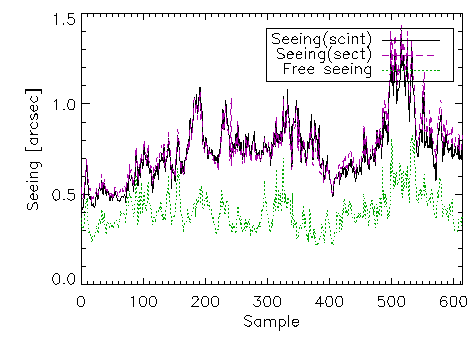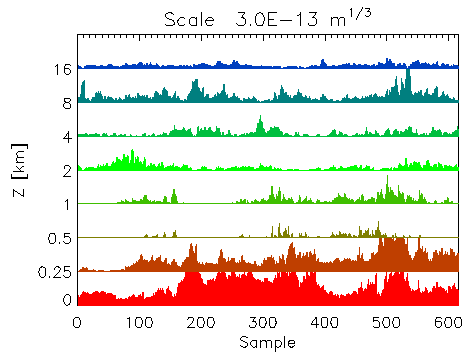RINGSS (Ring-Image Next Generation Scintillation
Sensor) is an instrument to measure vertical distribution of
turbulence in the terrestrial atmosphere by analysing scintillation
(twinkling) of bright stars. It is a fusion of the known DIMM
and MASS concepts in one
instrument based on a low-noise CMOS camera.
Image of a bright star in a small telescope with an annular aperture is shaped into a ring by introducing a tiny conic aberration. The star is focused in the radial direction, and the differential motion of opposite ring segments is analogous to the differential motion measured by a DIMM, providing estimate of the total seeing. Distribution of the light intensity along the ring (in angle) reflects illumination in the telescope pupil, and its statistical analysis leads to a low-resolution turbulence profile, like in MASS. However, turbulence near ground also produces intensity modulation, so RINGSS can measure the total seeing by scintillation as well as by the image motion. These two independent seeing measurements must be similar, assuring quality control. The principle is described in the 2021MNRAS.502..794T paper.
|

|
 |

Average ring image from a bright star (left) and its computer
model (right). The image is 64x64 pixels, pixel size 1.78
arcseconds. Cubes of 2000 such images with 1 ms exposure each are taken and
processed online. See a movie of
turbulence-distorded rings recorded on the sky.
|
The picture shows a RINGSS instrument during tests at Cerro Tololo in May 2022. The telescope is Celestron 5SE (127 mm diameter), the compact equatorial mount is RST-135 from Rainbow Astro, and the CMOS camera is ASI 290MM from ZWO (1Kx2K pixels).
The cylindrical enclosure was developed and fabricated at CTIO; it provides an almost hermetic protection of the telescope and mount and a minimum cross-section when open.
The plots below illustrate RINGSS data for the night of May 11/12,
2022 (614 measurements with 1-min cadence during 10 hours). The total seeing measured from scintillation (black line) and from differential sector motion (magenta) is in good agreement. The free-atmosphere seeing (excluding the 0.5-km ground layer, green dotted line) is always better than the full seeing. The right-hand plot shows temporal evolution of turbulence profile in the 8 layers at fixed heights of 0, 0.25, ... 16 km above ground. All data refer to 500nm walenength at zenith. A report on the first tests is available here.
Software for RINGSS
- Data processing in IDL: the code and its
description
- Data processing in python: the code and its
description
Documents
-
Bustos, E., Tokovinin, A., Rivera, R.
Site Monitor Based on the RINGSS Concept.
2025, J. Astron. Telesc. Instrum. Syst. 11(2), 027001.
[PDF, 3.6MB] ,
doi:10.1117/1.JATIS.11.2.027001
- Seeing at the SARA telescope: comparison with Tololo platform.
Tokovinin, A., Bustos, E., Rivera, R.
2024-10-24.
PDF, 823K
- A comparison of next-generation turbulence prfiling instruments at Paranal.
Griffiths, R., Bardou, L., Butterley, T., Osborn, J., Wilson, R., Bustos, E., Tokovinin, A., Le Louarn, M., Otarola, A. 2024, MNRAS, 529, 320
[PDF, 2MB]
ADS: 2024MNRAS.529..320G
- Paranal site-testing campaign of 2023: preliminary RINGSS results.
A. Tokovinin E. Bustos, 2023-04-06.
PDF, 845K
- Portable turbulence profilers: from MASS to RIGSS.
A. Tokovinin E. Bustos, R. Rivera. in: Communicatins and Observations through Atmospheric Turbulence, Durnam, March 27-31, 2023.
paper (PDF, 100K) and
presentation (PDF, 185K)
- Investigation of turbulence profile restoration in RINGSS.
A. Tokovinin, 2023-03-28.
PDF, 260K
- Comparison between RINGSS and MASS-DIMM at Cerro Tololo.
A. Tokovinin, 2023-02-22.
PDF, 2.7M
-
First comparisons between RINGSS and MASS-DIMM at Tololo.
A. Tokovinin, E. Bustos, R. Rivera, 2022-05-13.
PDF, 1.6M
- Measurement of low-order aberrations in RINGSS.
A. Tokovinin, 2021-06-10.
PDF, 118K
- Spectral response of RINGSS. A. Tokovinin, 2021-05-25.
PDF, 57K
- Dependence of the RINGSS weight on the star color.
A. Tokovinin, 2021-05-11
PDF, 104K
-
RINGSS turbulence sensor based on Celestron Nexstar 5SE.
A. Tokovinin, 2021-03-20. PDF, 280K
- Correction of saturated scintillation in RINGSS.
A. Tokovinin, 2020-09-10 PDF, 296K
- Biases of a ring-image turbulence sensor.
A. Tokovinin, 2020-09-10 PDF, 119K
- Response functions of a ring-image turbulence profiler.
A. Tokovinin, 2020-09-08
PDF, 168K
- Temporal response of RINGSS.
A. Tokovinin, 2020-09-01
PDF, 112K
- Characterization of the CMOS camera for solid-state MASS.
A. Tokovinin, L. Peige, 2020-02-28
PDF, 462K
Last modified: Oct 28, 2025.
A. Tokovinin (andrei.tokovinin-AT-noirlab.edu)




